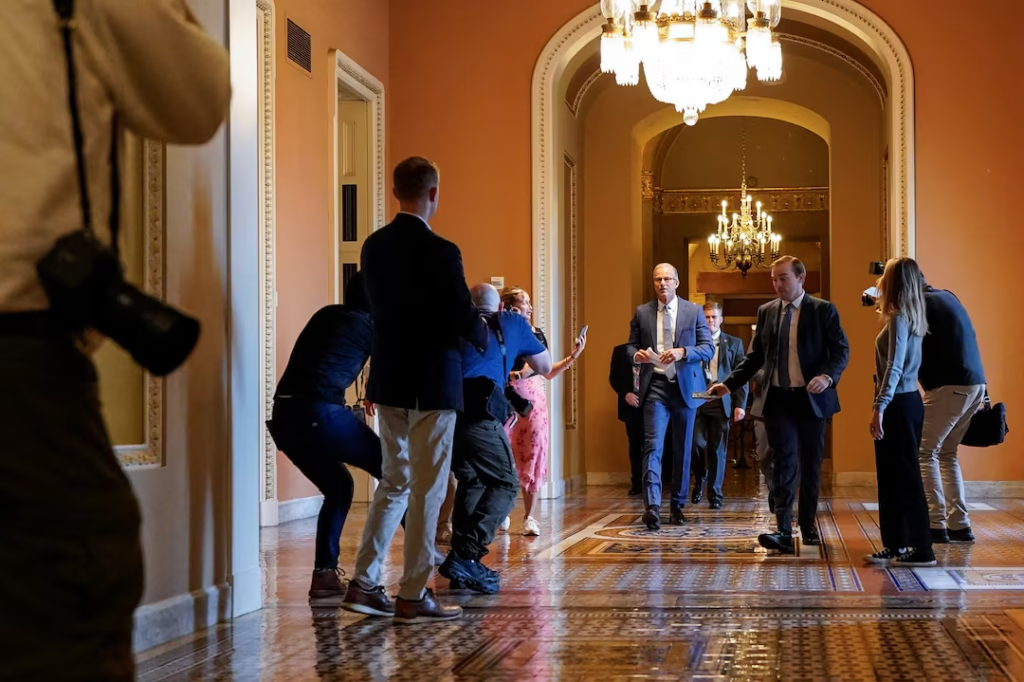Introduction: A Bill Like No Other
In July 2025, the United States Senate is in the midst of political dysfunction, fiscal controversy, and popular criticism regarding one of the most sweeping legislative packages in U.S. history. Ex-President Donald Trump’s $3.3 trillion tax and spending bill — commonly referred to as the “One Big Beautiful Bill” — is experiencing a high-drama vote-a-rama in the Senate. This round-the-clock voting marathon is reshaping conversations around taxation, healthcare, federal spending, and the future of the American economy.
This article breaks down the details, progress, and controversies surrounding the bill and explores the broader implications for the U.S. government, economy, and public services.
What is a Vote-a-Rama?
Understanding the Procedure
A vote-a-rama is a special Senate process employed with budget reconciliation. It permits a limitless number of amendments to a bill, each of which has to be voted on before it passes finally. Senators from both sides can offer amendments that have nothing to do with, or are loosely tied to, the bill’s actual substance.
Why It Matters
Since reconciliation bills cannot be filibuster, they need a simple majority to pass. This makes the vote-a-rama one of the most influential and frenetic legislative events in American politics — especially in a politically polarized Senate.
Background of Trump’s $3.3 Trillion Spending Bill
Bill’s Main Goals
- Trump’s proposed bill is a wide-ranging effort to:
- Cut taxes on individuals and businesses
- Increase defense and border security appropriations
- Reduce social programs such as Medicaid and SNAP
- Invest in infrastructure, such as AI and space technology programs
Allocations

The bill is designed to be revenue-neutral after 10 years through a projection of economic growth and suggesting offset reductions in welfare and healthcare programs.
Timeline: From Proposal to Vote-a-Rama
April 2025: Trump introduces his “One Big Beautiful Bill” at the Conservative Economic Forum.
May 2025: Bill is introduced in the House, with opposition mounting immediately.
June 2025: House passes the bill narrowly, sending it to the Senate.
July 1–Present: Senate moves into vote-a-rama to consider more than 150 proposed amendments.
Highlights of Key Amendments
✅ Passed Amendments
Childcare Tax Credit Expansion: Gains support from moderate Republicans and some Democrats.
AI Infrastructure Funding: $50 billion added for AI highways and public sector innovation.
Veterans Healthcare: An amendment adding benefits by $30 billion passed overwhelmingly.
❌ Rejected Amendments
Medicaid Expansion Protections: Rejected along party lines.
Climate Resilience Projects: Several proposals were rejected for being too expensive.
???? Still Under Debate
- National Sales Tax Implementation
- Digital Dollar Integration Plan
- State-Level Block Grant Reform for SNAP
Who Supports the Bill?
✅ Republican Caucus
Almost all Senate Republicans have expressed enthusiasm, particularly from Trump allies such as Senators Josh Hawley and J.D. Vance, who view the bill as a realization of Trump’s second-term agenda.
???? Moderate Republicans & Independents
Senators Lisa Murkowski and Joe Manchin are undecide, requesting assurances on social service protections.
❌ Democratic Opposition
Senate Democrats have voted unanimously against the bill, condemning it as a “tax cut for the rich” and a “gutting of essential public programs.”
Economic and Social Implications
???? Tax Cuts and Wealth Distribution
The bill contains deep tax cuts:
- Lowers corporate tax rate from 21% to 15%
- Cut in top rate of individual income tax from 37% to 28%
- Provides tax credits for families with children and married couples
- Critics say it unfairly favors the rich and will expand the gap between rich and poor.
???? Healthcare Cuts
- Reduces funding for Medicaid by more than $300 billion
- Turns Medicaid into a block grant program
- Includes work requirements for recipients of SNAP and welfare programs
- Analysts estimate 10 million Americans may lose access to healthcare.
????️ Infrastructure Spending
This bill, unlike previous Trump proposals, contains an infrastructure plan looking to the future:
- National 6G internet backbone
- Clean water projects for rural areas
- Smart roads with AI sensors embedded
Public Opinion
???? Most Recent Polling (July 1, 2025) – Pew Research

Although Republicans show broad support for the bill, independents and Democrats are skeptical due to the bill’s apparent favoritism towards corporations rather than citizens.
What Critics Are Saying
???? Senator Elizabeth Warren
“This isn’t a budget—it’s a billionaire giveaway while working families are left behind.”
???? Economist Paul Krugman
“The math doesn’t add up. You can’t fund this many tax cuts with wishful thinking about growth.”
???? Center on Budget and Policy Priorities
“More than 25 million Americans might lose housing, healthcare, and food assistance if this bill passes.”
What Supporters Are Saying
???? Senator Josh Hawley
“It’s bold, it’s American, and it puts families, jobs, and patriotism at the center of our future.”
???? Trump’s Official Statement
“This bill is the greatest, most gorgeous, most tremendous budget in United States history. It puts America First and will be remembered for centuries.”
Global Reactions
???? International Markets
- The U.S. currency experienced minor fluctuations in the face of uncertainty.
- Asian and European markets were wary.
- Long-term expansion of U.S. debt scares foreign investors.
???????? China’s Comment
“This amount of tax reduction and defense expenditure will cause global imbalances.”
What Happens Next?
⏳ Final Senate Vote
The Senate will finish the vote-a-rama on July 3, 2025, before the Independence Day recess.
???? House Reconciliation
In case the bill is passed with amendments, it has to go back to the House for reconciliation.
????️ Presidential Signature
Trump has said he would sign the bill right away if it is passed, describing it as the “Second Declaration of Independence.”
Conclusion
The Senate vote-a-rama on Trump’s $3.3 trillion spending bill is a turning point in contemporary U.S. politics. Whether praised as a daring step forward or condemned as irresponsible, the legislative process in motion will determine the course of the nation for years to come. With ideological fault lines more acute than ever and the 2026 midterms already on the calendar, this bill is not merely about figures—it’s about the soul and strategy of America’s future.
FAQs
❓ Where is the bill now?
The bill remains pending as part of the Senate’s vote-a-rama process. A final vote will occur before July 4.
❓ Is it likely to pass?
The bill requires almost all Republican votes in the Senate. A handful of centrist GOP senators are undecided, and their decision will make the difference.
❓ Why do they call it “One Big Beautiful Bill”?
The name was coined by former President Donald Trump during his re-election bid, labeling it as his signature legislative comeback.


